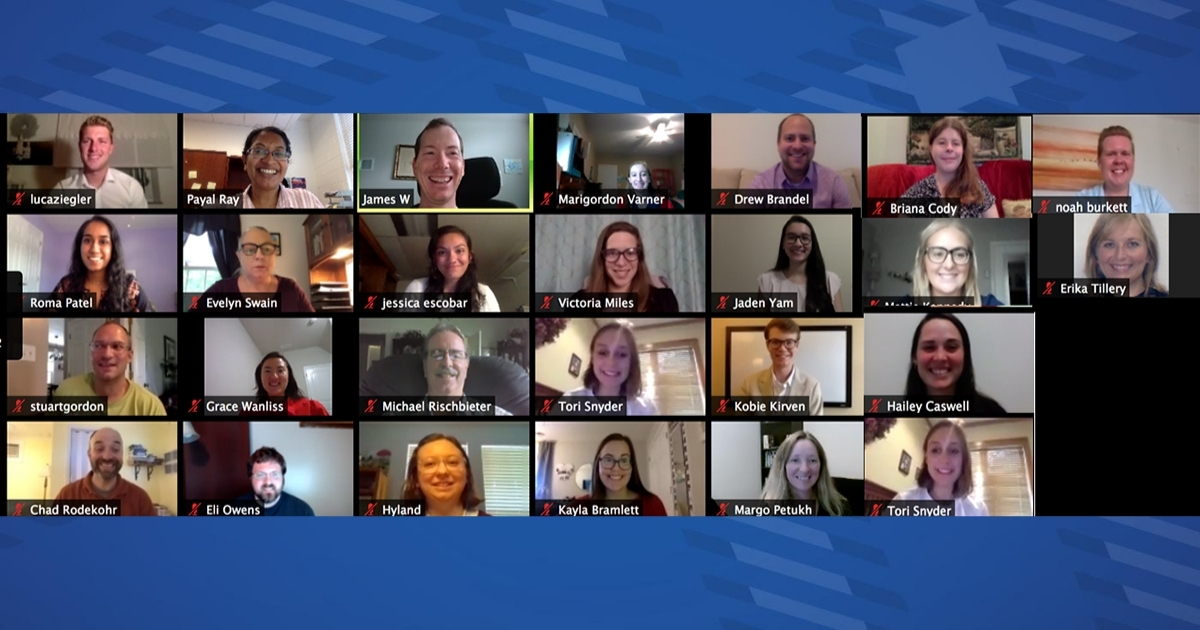Students Conduct, Present Research Virtually
 The Summer Research Symposium typically takes place in Harrington-Peachtree and the James H. Thomason Library.
The Summer Research Symposium typically takes place in Harrington-Peachtree and the James H. Thomason Library.
Some students present their summer research findings to a crowd of fellow students and professors in HP before others deliver poster presentations in the library.
But this year was different. Students conducted research from home and shared their findings virtually. Although miles apart (one student, Luca Ziegler, was at home in Germany), they all convened via video conferencing during the Summer Research Symposium on Wednesday, July 29.
Undergraduate Research Away from Campus
“I am pleased to see how much the students have achieved in these eight weeks,” said Dr. Payal Ray, biology professor and director of the Summer Research Symposium.
For rising seniors, like Briana Cody and Hyland Gonzalez, this summer was one of the last opportunities to conduct and present research. For others, like Noah Burkett, this summer was a chance to conduct research before their plates get too full.
“We know that one of the key aspects of research is dissemination of findings, and this symposium is a means to that end,” Ray said.
Adjusting to a Virtual Format
Since science-related research is so hands-on, Ray wasn’t sure how much progress students would make while conducting research virtually. But adjusting to a virtual format presented learning opportunities that she didn’t anticipate.
“Moving to a remote format necessitated some changes in the original proposals,” Ray said. “I took this as an opportunity for students to think on their feet, which all did extraordinarily well.”
Ray advised Jess Escobar as she conducted research on regulation of gene expression. When the decision was made to research remotely, the two thought about how to use computational biology to inform experiments that they’ll conduct this fall. The findings from this summer’s research have supported the proposed Fall research.
“We learn best when we teach”
“We got to learn a lot of new things that we hadn’t anticipated learning when we wrote the summer proposal,” Ray said.
“Even if a student did not complete all the research that they had proposed or anticipated completing over summer, just the process of explaining their project, objectives, methods and how and why they proceeded the way they did – helped develop analytical skills.”
According to Ray, presenting research, like students did during the symposium, was itself a learning opportunity.
“When the students presented their research, they basically taught the audience something that the latter doesn’t know,” Ray said. “We learn best when we teach. When students presented their work, they gained an even better understanding of the field and their own research.”
This Year’s Summer Researchers
This year’s summer researchers included:
Kayla Bramlett – Glucose Transport Structure/ Function Studies in Saccharomyces cerevisiae: Characterization of Hxt2p
Noah Burkett – Comparative Analysis of Functional Activity of SSD in NPC1 and NPC1-Like Protein
Hailey Caswell- Expression Analysis of Cancer Cell Lines Treated with Omeprazole
Briana Cody, Modifications to the Rope Braiding Machine at Presbyterian College
Daijah Davis, Melissa Rogers – Impact of Pharmacist counseling at discharge
Alex Eisenschmied, Upregulation of Metastatic Genes in HT29 and Caco-2 cells Induced with Losartan and Treated with Chemotherapeutics
Jess Escobar, A computational approach to investigate the role of zinc finger protein, ZF30C in epigenetic repression of Drosophila engrailed gene
Hyland Gonzalez, The Mexican Revolution and women in post-revolution Mexico
Reid Haigler- Whisker Occurrences
Kobie Kirven and Mattie Kennedy, The Effects of Dietary Iron on the Taxonomic and Functional Composition of the Gut Microbiome in Zebrafish, Danio rerio
Ryan McCall – An investigation on the impact of Hsp90 isoform and co-chaperone inhibitors on lipopolysaccharides (LPS)-induced NF-κB and Nrf2 activation in microglial cells
Victoria Miles and Roma Patel, Pain Associated with Heat Shock Protein 90 Inhibitor Use: A Systematic Review and Meta Analysis
Tori Snyder – Cosmic Rays and Galactic Motion
Marigordon Varnier, Interpreting Myoelectric Signals via Machine Learning Algorithms
Grace Wanliss – Cosmic Rays, Space Weather and Human Chronobiology
Jaden Yam – Paleopalynology of the Eocene/Oligocene Transition in the White River Badlands of WY
Luca Zeigler, Grit and its Relationship with Athletic Performance
